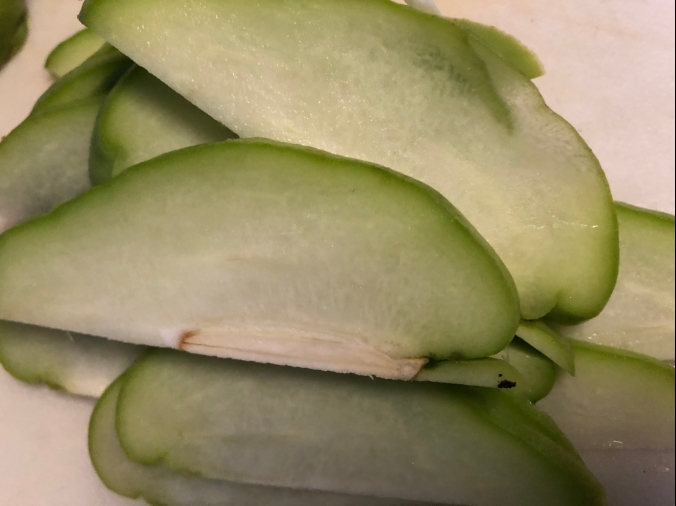
-
From the bottom, chayote fruit reminds me of a grumpy sock-puppet. I wish I had added googly eyes.
SCIENTIFIC NAME: Sechium edule
COMMON NAMES: A plethora, many of which don’t resemble the word chayote at all, such as mirliton (Louisiana), choko (Australia), christophine (Caribbean), chuchu (Brazil), and vegetable pear. The golden prickles on some varieties of chayote give rise to the Chinese name of lóng xü cài (龙须菜), “dragon-whisker vegetable.”
ORIGIN: “Chayote” comes from the Nahuatl (Aztec) name chayohtli, and the Aztecs were the first people to cultivate the plant. Like tomato and many other indigenous Mexican crops, chayote was spread far and wide by Europeans after the Spanish conquest of Mexico in the 16th century. It is now cultivated and eaten throughout the world’s warm regions, especially in the Caribbean, Latin America and parts of Asia.

- Sliced chayote with the soft, edible seed left in.
FUN FACTS:
- An enduring Australian food legend claims that McDonald’s apple pies are filled with choko (chayote) disguised as real apple. While this is false, it is true that Australians once added chayote to pies during food shortages to stretch canned apples and pears, making this perhaps the most innocuous food secret McDonald’s has been accused of keeping.
- The small Colombian mountain town of San Bernardo is known for the unusually well-preserved remains of its dead. No one knows exactly why people mummify after death in San Bernardo, but some attribute it to a local diet rich in chayote and another fruit, a tree-bean called balú. As the miraculous mummification preserves clothing and objects as well as bodies, it can’t all be chalked up to diet, although chayote is said to promote cellular regeneration.
- Like some other gourds, all parts of the chayote plant are edible, including the large seed inside the fruit. The roots are similar to potatoes, while the shoots and leaves are prized for soups, salads and stir-fries. The fruit may be eaten raw or cooked.
 FLAVOR: Raw chayote has a pleasant, crisp texture similar to apple and a faint sweetness. Because the flavor is so mild, think of chayote as one of those “blank canvas” type of ingredients that readily accepts a range of seasonings. I tried two completely different recipes with mine and they both turned out delicious (half went into a Thai salad with fish sauce, sugar, tomato, apple and cashews, and half was sauteed with butter, garlic and parsley, a combination of ingredients which reminded me inescapably of escargot).
FLAVOR: Raw chayote has a pleasant, crisp texture similar to apple and a faint sweetness. Because the flavor is so mild, think of chayote as one of those “blank canvas” type of ingredients that readily accepts a range of seasonings. I tried two completely different recipes with mine and they both turned out delicious (half went into a Thai salad with fish sauce, sugar, tomato, apple and cashews, and half was sauteed with butter, garlic and parsley, a combination of ingredients which reminded me inescapably of escargot).



 FLAVOR: Raw chayote has a pleasant, crisp texture similar to apple and a faint sweetness. Because the flavor is so mild, think of chayote as one of those “blank canvas” type of ingredients that readily accepts a range of seasonings. I tried two completely different recipes with mine and they both turned out delicious (half went into a
FLAVOR: Raw chayote has a pleasant, crisp texture similar to apple and a faint sweetness. Because the flavor is so mild, think of chayote as one of those “blank canvas” type of ingredients that readily accepts a range of seasonings. I tried two completely different recipes with mine and they both turned out delicious (half went into a
You must be logged in to post a comment.